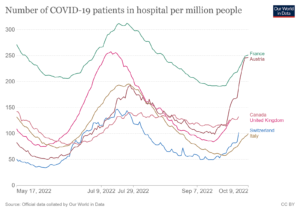A range of new Covid-19 subvariants are currently circulating overseas, and some have already reached our shores.
With summer around the corner, the SMC asked experts to comment on what the Covid-19 landscape is looking like right now in other countries, and how it might affect Aotearoa New Zealand.
Dr Joep de Ligt, Lead Bioinformatics & Genomics, ESR, comments:
“It is clear that the next wave of COVID-19 is building in the Northern Hemisphere, with hospitalisations rising rapidly. Countries like Austria surpassed their previous wave within a matter of weeks and several others are not far behind.

Figure 1. Source: Our World in Data. Hospitalised cases per million over a half year period. CC BY 4.0
“What is also becoming clearer is that these waves are driven by a variety of new variants, most of them descendants from our previous waves. Because these waves were not met by strong public health action they have been given the opportunity to spread and evolve into these new forms.
“As Eric Topol highlights in this thread, these variants share common mutations, called convergent evolution. These mutations seem to convey immune evasive properties meaning that immunity from previous infections and vaccines offer less protection as well as that monoclonal antibody treatments will be less effective. This has led to increased calls for boosters and the new bi-valent vaccine to be rolled out widely and quickly to help prevent health systems from being overwhelmed and keep people safe.
“One particular variant BQ.1.1 is being monitored due its competitive advantage over the ancestral BA.5 with estimates around 12-14%, putting it ahead of BA.2 and BA.5 advantage over their predecessors, for which New Zealand saw rapid replacements.”
Conflict of interest statement: Dr de Ligt was part of a Ministry of Business, Innovation and Employment (MBIE) COVID-19 Innovation Acceleration Fund project to establish genomics capability for SARS-CoV-2 research and surveillance. The ongoing work is funded by Te Whatu Ora to sequence the genomes of all of New Zealand’s PCR positive COVID-19 cases and track how the virus spread across New Zealand.
Professor Michael Plank, Te Pūnaha Matatini and University of Canterbury, comments:
“Many Northern Hemisphere countries are currently in a Covid wave that looks like it’s being caused by a combination of waning immunity, changing seasons, and new variants spreading. The variant situation is more complicated than in previous Omicron waves, which have each been dominated a single subvariant – first BA.1, then BA.2 and most recently BA.5. This time, there is a variant soup consisting of several different lineages that appear to be outcompeting BA.5.
“Some of these subvariants are already spreading in New Zealand and it’s likely they will trigger a wave here as well. The size of the wave is highly uncertain – it could be on a par with the BA.5 wave we had in July. It could be smaller as we move towards summer and people spend more time outdoors, making it harder for the virus to spread. Or it could be more prolonged if some of faster-growing lineages take hold.
“We have reached a stage of the pandemic where waves of Covid-19 occur in a cycle. These waves recede when enough immunity has built up from a combination of vaccination and prior infection. But over time that immunity wanes and the virus evolves to bypass it, allowing the cycle to start again. This is an inevitable cycle in a respiratory pathogen that is becoming endemic. Our best tools to mitigate it are vaccines and treatments that reduce the risk of severe illness. Many countries including Australia are now deploying updated Omicron vaccines to strengthen and broaden immunity, particularly in high-risk groups.”
Conflict of interest statement: “Michael Plank is funded by the Department of Prime Minister and Cabinet for mathematical modelling of Covid-19.”
